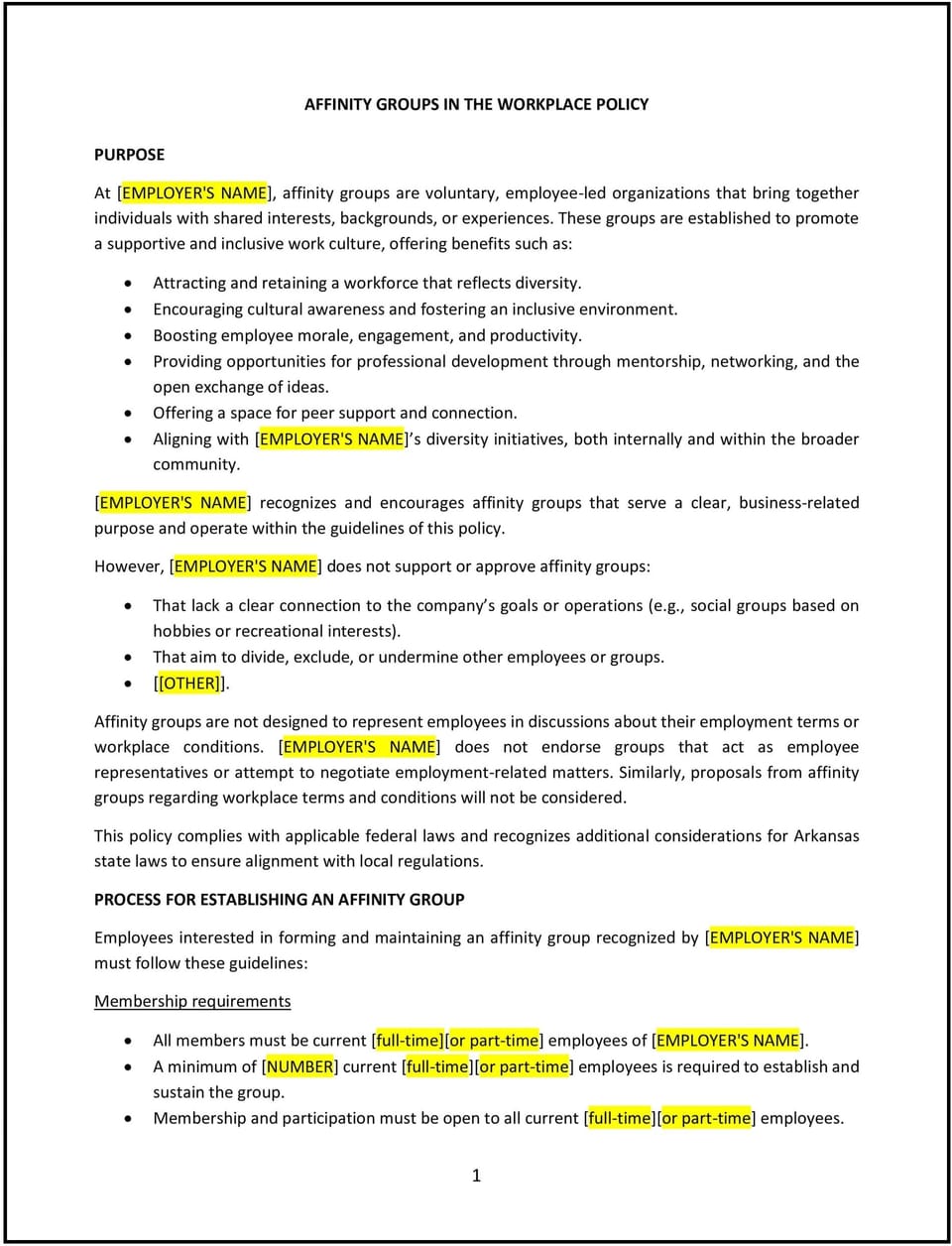Affinity groups in the workplace policy (Arkansas): Free template

Affinity groups in the workplace policy (Arkansas)
In Arkansas, an affinity groups policy provides businesses with guidelines for establishing and managing employee-led groups centered around shared identities, interests, or goals. These groups, also known as employee resource groups (ERGs), aim to foster inclusion, support employee development, and enhance workplace culture.
This policy outlines the process for creating, maintaining, and evaluating affinity groups while ensuring alignment with the business’s objectives and compliance with state and federal laws. By implementing this policy, Arkansas businesses can create a more inclusive and supportive workplace environment.
How to use this affinity groups policy (Arkansas)
- Define purpose and scope: Clearly outline the objectives of affinity groups, such as promoting diversity, supporting professional growth, and creating a sense of belonging for employees with shared characteristics or interests.
- Establish formation procedures: Provide guidelines for forming affinity groups, including the requirement for a written proposal, leadership structure, and approval by HR or management.
- Align with business values: Ensure that all affinity groups align with the company’s mission, values, and business goals while adhering to workplace policies.
- Provide support: Outline the resources available to affinity groups, such as meeting spaces, budgets, or executive sponsorship, to help them achieve their objectives.
- Set accountability measures: Establish expectations for reporting on activities, membership growth, and contributions to the workplace, ensuring that affinity groups remain active and effective.
Benefits of using this affinity groups policy (Arkansas)
This policy offers several advantages for Arkansas businesses:
- Promotes inclusivity: Encourages diversity and fosters a workplace culture where all employees feel valued and supported.
- Enhances employee engagement: Provides employees with opportunities to connect with peers, share experiences, and collaborate on initiatives that benefit the organization.
- Supports talent retention: Creates a more supportive work environment, improving employee satisfaction and reducing turnover.
- Drives innovation: Affinity groups bring diverse perspectives to the workplace, which can lead to creative problem-solving and innovative ideas.
- Ensures compliance: Aligns with Arkansas and federal non-discrimination laws, ensuring that affinity groups operate within legal boundaries.
Tips for using this affinity groups policy (Arkansas)
- Address Arkansas-specific considerations: Ensure the policy reflects any state-specific labor laws or cultural factors relevant to workplace inclusion and diversity initiatives.
- Provide training: Offer training for affinity group leaders on effective group management, conflict resolution, and alignment with business objectives.
- Encourage executive sponsorship: Involve senior leaders as sponsors to provide guidance and resources while reinforcing the importance of the groups to the business.
- Monitor effectiveness: Regularly evaluate the impact of affinity groups on employee engagement, workplace culture, and business outcomes.
- Communicate openly: Promote the existence and purpose of affinity groups to all employees to encourage participation and foster a sense of inclusivity.
Q: How does this policy benefit the business?
A: This policy fosters inclusivity, boosts employee engagement, and promotes innovation by creating spaces for employees to connect, collaborate, and contribute to the business’s objectives.
Q: How can employees start an affinity group?
A: Employees interested in forming an affinity group must submit a written proposal outlining the group’s purpose, goals, and structure. HR or management will review and approve the proposal based on alignment with business values.
Q: What resources does the business provide to affinity groups?
A: The business may provide resources such as meeting spaces, small budgets, or executive sponsorship to help affinity groups achieve their goals while maintaining alignment with company objectives.
Q: How does the business ensure that affinity groups operate inclusively?
A: The business requires that affinity groups welcome all employees who wish to join and ensures that group activities align with the company’s non-discrimination policies.
Q: How are affinity groups evaluated?
A: Affinity groups are expected to report regularly on their activities, membership growth, and contributions to workplace culture. HR or management reviews these reports to assess their effectiveness and alignment with business goals.
This article contains general legal information and does not contain legal advice. Cobrief is not a law firm or a substitute for an attorney or law firm. The law is complex and changes often. For legal advice, please ask a lawyer.


